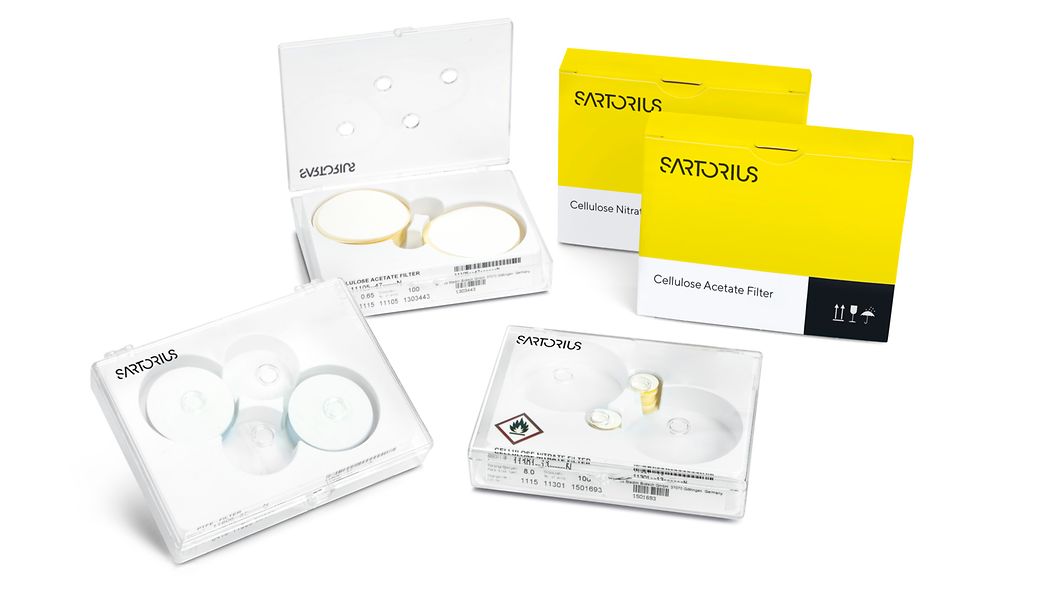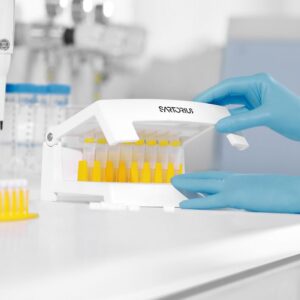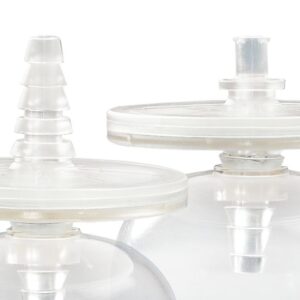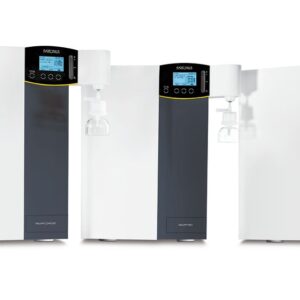Membrane Filters
Available on backorder
Sartorius Membrane Filters, a Membrane for Nearly Every Need
Our membranes and recommended use(s):
- CN: Nitrocellulose — Blotting of proteins or DNA
- CN (MCE): Cellulose Nitrate (Mixed Cellulose Ester) — Particle Retention and Cell Capture in aqueous solutions or air
- CA: Cellulose Acetate — Particle Retention and Removal for aqueous solutions or air
- RC :Regenerated Cellulose — Particle Removal for solvents or aqueous solutions
- PES: Polyethersulfone — Filter aqueous media or solvent Pharmaceutical Solutions & mixtures
- PA: Polyamide — Particle Removal for solvents
- PTFE: Polytetra-fluoroethylene for solvents and gases — Particle Removal
- PC-TEM: Polycarbonate Track-etched Membranes — Particulate Analysis in solvents or aqueous solutions or medias
DHC is an authorized Channel Partner for Sartorius. To get Sartorius products at best discounts mail your enquiry on info@dharidasandco.com
Cellulose Nitrate (CN) Membrane Filters
The membrane that started it all
Cellulose nitrate or mixed cellulose ester membrane filters are indicated for many general laboratory applications where a membrane with high non-specific adsorption is suitable. This membrane is made of even cellulose nitrate, a material which assures effective retention with high flow rates and optimum colony growth.
Cellulose Acetate (CA) Membrane Filters
The filter of choice for sterile filtration of aqueous solutions
Cellulose acetate membranes combine high flow rates and thermal stability with very low adsorption characteristics and are therefore excellently suited for use in pressure filtration devices.
CA membrane filters are hydrophilic, have high flow rates thanks to their symmetric structure, and are compatible with aqueous solutions (pH 4 – 8), oils, alcohols and other organic solvents.
Polyethersulfone (PES) Membrane Filters
Perfectly suited for clarification of aqueous solutions
Polyethersulfone (PES) membrane filters are hydrophilic membranes with high flow rate and low non-specific protein adsorption.
These properties make them excellent for the filtration of aqueous solutions as well as various solvents and pharmaceutical solutions.
Regenerated Cellulose (RC) Membrane Filters
Regeneration never worked so well
Regenerated Cellulose membranes are very low adsorption membranes that are also hydrophilic, solvent-resistant (pH 3-12) and excellently suited for particle removal from solvents.
These properties make them excellent for the filtration of aqueous solutions as well as various solvents and pharmaceutical solutions.
Polyamide (PA) Membrane Filters
Chemically resistant to alkaline solutions & organic solvents
Polyamide membrane filters are hydrophilic and chemically resistant to alkaline solutions and organic solvents. They are therefore recommended for the particle removal from aqueous solutions and solvents for analytical determination such as HPLC.
They are also suitable for the sterile filtration of these liquids as well as for applications where a membrane with a relatively high nonspecific adsorption is acceptable.
Hydrophobic Polytetra-fluorethylene (PTFE) Membrane Filters
Don’t get wet, get even
Hydrophobic PTFE (polytetra-fluorethylene) membranes are permanently hydrophobic. The main application of these membrane filters is the filtration of air, gases or chemicals.
Unlike other (hydrophilic) filter types, they are not wetted by air humidity, allowing unhindered passage of air at low differential pressures as well. PTFE membrane filters have an excellent chemical compatibility (pH 1 to 14), so that they are also used for the filtration of solvents and acids, to which other filter types are not resistant. Moreover, they can be used to filter aqueous solutions as well, but, because of their hydrophobic characteristics, they must be pre-wetted with ethanol or methanol before the filtration of aqueous media solutions.
Polycarbonate Track-Etched (PC-TEM) Membrane Filters
Accuracy is key
Polycarbonate Track-Etched (PC-TEM) membranes are uniquely structured membranes designed for mostly specialized uses where their unique properties can be exploited.
These white and hydrophilic polycarbonate track-etched membranes are manufactured from high grade polycarbonate film using track-etch technology. The etching allows their capillary pore structure to be uniform and precise, making a membrane with a narrow pore size distribution, and thus, are excellent for precise particle retention and analysis.
Polyethersulfone (PES) Membrane Filters
Perfectly suited for clarification of aqueous solutions
Polyethersulfone (PES) membrane filters are hydrophilic membranes with high flow rate and low non-specific protein adsorption.
These properties make them excellent for the filtration of aqueous solutions as well as various solvents and pharmaceutical solutions.
Regenerated Cellulose (RC) Membrane Filters
Regeneration never worked so well
Regenerated Cellulose membranes are very low adsorption membranes that are also hydrophilic, solvent-resistant (pH 3-12) and excellently suited for particle removal from solvents.
These properties make them excellent for the filtration of aqueous solutions as well as various solvents and pharmaceutical solutions.
Polyamide (PA) Membrane Filters
Chemically resistant to alkaline solutions & organic solvents
Polyamide membrane filters are hydrophilic and chemically resistant to alkaline solutions and organic solvents. They are therefore recommended for the particle removal from aqueous solutions and solvents for analytical determination such as HPLC.
They are also suitable for the sterile filtration of these liquids as well as for applications where a membrane with a relatively high nonspecific adsorption is acceptable.
Hydrophobic Polytetra-fluorethylene (PTFE) Membrane Filters
Don’t get wet, get even
Hydrophobic PTFE (polytetra-fluorethylene) membranes are permanently hydrophobic. The main application of these membrane filters is the filtration of air, gases or chemicals.
Unlike other (hydrophilic) filter types, they are not wetted by air humidity, allowing unhindered passage of air at low differential pressures as well. PTFE membrane filters have an excellent chemical compatibility (pH 1 to 14), so that they are also used for the filtration of solvents and acids, to which other filter types are not resistant. Moreover, they can be used to filter aqueous solutions as well, but, because of their hydrophobic characteristics, they must be pre-wetted with ethanol or methanol before the filtration of aqueous media solutions.
Polycarbonate Track-Etched (PC-TEM) Membrane Filters
Accuracy is key
Polycarbonate Track-Etched (PC-TEM) membranes are uniquely structured membranes designed for mostly specialized uses where their unique properties can be exploited.
These white and hydrophilic polycarbonate track-etched membranes are manufactured from high grade polycarbonate film using track-etch technology. The etching allows their capillary pore structure to be uniform and precise, making a membrane with a narrow pore size distribution, and thus, are excellent for precise particle retention and analysis.







There are no reviews yet.